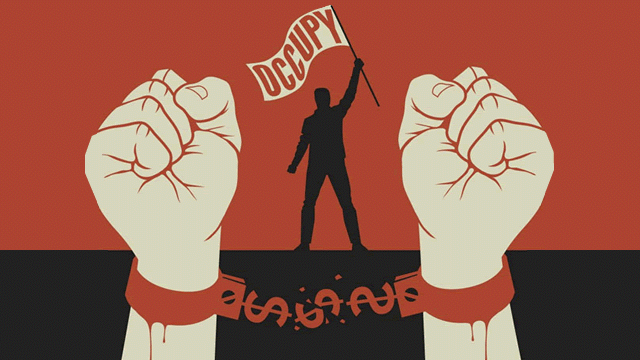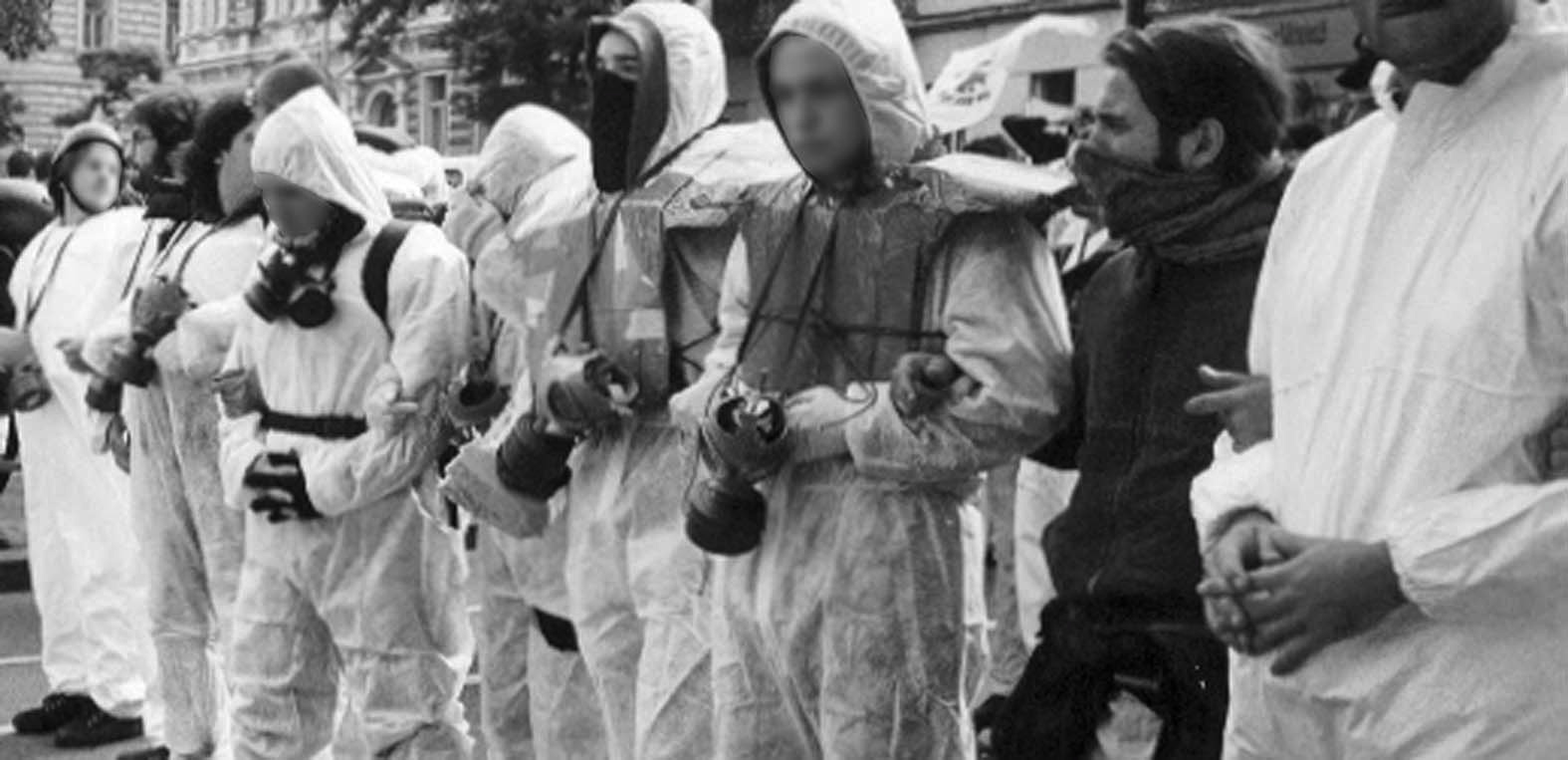
Over the past few weeks activists with OWS have been reflecting on the last two years of struggle. Some are quick to call out others' mistakes and lambast each others' ideas as either too liberal or too crazy. Some people’s thoughts are more reflexive and highlight their own successes and failures. During a discussion over an email list, Justine Tunney, an admin of Occupwallst.org (which also includes large followers on Twitter and Facebook), proposed diversifying the form for street protest by building an “Occupy Militia.”
During the same week at the EcoSocialist Conference in L.A., a similar discussion was held about “raising armies” stirred by former Occupy L.A. participants engaging a panel on electoral reform. Seeing these similar proposals spark conversation in New York City and L.A. suggests that there are others having analogous ideas in between the coasts. Here, I explore how Americans perceive and talk about militias, and juxtapose it to the emergence of the White Overalls brigades in Italy, who managed to tactically innovate during heavy police repression.
In NYC, Tunney called for a “nonviolent militia” that would put their bodies between the protesters and police. The militia would be trained in protest tactics and outfitted with body armor. She estimated that it would take one million dollars to organize, equip, and compensate those willing to put it all on the line. The cash and the militia would crowd sourced. In L.A., debate about the extent of the climate crisis prompted activists to discuss building communes to encourage sustainable living practices as well as form an "army" organized with "a singular and unified mindset."
Tunney was met with varied response on the email thread. While some supported this idea, others called it “illegal” and “crazy.” All discussion ended when a moderator asked that the topic be moved to another email list so that those worried about legalities would not leave the group. In L.A., the discussion about raising an army devolved into shouting as some griped, “Surely, you do not mean with guns?” and “Are you calling for civil war?”
In both cases, the paranoia is certainly related to activists’ use of military-style vocabulary. When the words militia and army arise in serious conversations, common points of reference are visions of bullets, bombs, and death. From the US Army to the Michigan Militia, these words feel ugly to say because of the destruction caused by these groups. But, why do Americans equate the idea of an "army" or "militia" with weapons?
America’s provocative Second Amendment reads, “A well regulated Militia, being necessary to the security of a free State, the right of the people to keep and bear Arms, shall not be infringed.” While the 21st century popular interpretation of the 2nd amendment focuses on an abstracted clause, “the right to bear arms,” this amendment initially justified the Federal Government’s creation of a national standing army to protect against insurrection.
It was also used to support the adoption of armed local police forces. Debate on what was meant by “militia” oscillates between the state’s right to organize a disciplined guard in the service of the national militia versus the individual right to own a weapon for the purpose of being part of the national militia. Note that “militia” is not plural and neither is “state.” Here then, “well regulated” does not refer to the quality of discipline, but to federal legal regulation for owning guns when in the service of the national militia.
Further complicating the issue, the interpretation of this amendment by the US Supreme Court depends on historical differences in vocabulary and grammar so that the right to “bear arms” is considered separate from being part of the national militia. Today’s popular interpretation suggests that “bearing arms” is the same as “carrying weapons” as a guarantee against governmental tyranny. In this interpretation, forming a militia and/or owning a gun becomes an individual right to self-defense.
If activists were to organize and train a nonviolent militia or raise an army, they must rely on the same justification as those who insist this amendment protects an individual’s right to carry weapons. But, if the objective is to create a zone between the police and protesters then there already exist historical precedents without the need to call it a militia.
For example, members of Veterans for Peace stood between the police line and the protesters, sans armor, during many Occupy protests nationwide. They often hold the American flag and engage the officers during standoffs, which can last hours. Veteran Scott Olsen was near the police line when he was shot with a tear gas canister and permanently injured during the raid on Occupy Oakland.
In the liminal space between the state and the people, identity politics does not matter. Being a veteran is no guard against state violence. If the goal is to assemble a group with singular purpose and expert tactical repertoires, then significant training is necessary to stand up to the police as well as to foment popular resistance.
The white overalls (AKA Tute Bianche), is a useful model for analyzing the bridge between discipline and people power. In 1994, a group of protesters wearing white overalls successfully defended the eviction of a social center in Milan by surrounding the police and government buildings. In contrast to blue overalls, a typical uniform worn by the working class in Italy, white overalls symbolized the invisible class of precarious workers.
Animated by Italian Autonomous literature, a group of Italian activists traveled to Mexico City to learn strategies from the Zapatistas. They were also present in Seattle in 1999 and Quebec City in 2001. Their purpose was strategic: “We want to extend networks between grassroots, self-managed communities, we are not interested in nation-states.” Groups of protesters wearing white overalls captured the imagination of many during the G8 protests in Genoa 2001. But it wasn’t the white overalls or the ideology that put them in the media spotlight, it was their tactics.
As police suppression of white overalls protests grew, a plan for self-defense unfolded. The body armor of the police provided inspiration for protesters to wear gas masks, chest plates, goggles, and football helmets, while others donned padding made out of furniture cushions, bubble wrap, and styrofoam. The media called them “Michelin Men” because of the bulky attire. Another tactic was to wear or carry large inner tubes and plastic shields, which created distance between the protesters and the hungry arms of police. Props such as balloons, water pistols, and music were used to create a carnival atmosphere.
While padding reduced mobility and speed significantly, it also allowed protesters to move more deliberately en mass, like a tidal wave. It was not just well-ordered marching, but also the density of people and foam that mattered. It was cumbersome for police to make arrests because the bulky garb prevented handcuffing or placing protesters in police cars. When protestors change their body morphology by attaching items to their being, they also disrupt the tactics of the police who are trained to arrest "normal" bodies.
Is this the kind of street swarm needed for today’s policing techniques? How can this be effectively combined with other strategies of resistance, both offline and online?
I moved away from the language of a militia or army to reflect another style of resistance that emerged from police suppression. To be militant does not mean to be like the military. Using the vocabulary of war may not be the best course for activists who desire freedom from the state, but be sure it will get their attention and full force. The task is to find a fit between the symbols of a people’s movement, the discipline necessary to resist, and the values embedded within our actions.
With the camps, Occupy created roving communes across the USA where people were trained in group decision-making and nonviolent direct action. It served as a terrific complement to the foreclosure crisis and ignited continuing national resistance. If the hive mind is calling for bodies to fill the space between state violence and the people, then the white overalls remain an important paradigm to inspire activists worldwide. Yet, if the debate is about fostering a uniform purpose and goal, the strategy must rise from the chemistry of common life, where the tactics are both molar and polyvalent.
3 WAYS TO SHOW YOUR SUPPORT
- Log in to post comments



















